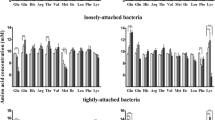Abstract
The bacterial level of soft feces is higher than that of hard feces in nutrias. This suggests the heterogeneity of bacterial density in the large intestine. To show the heterogeneity of bacteria in the contents of the large intestine in nutrias, we divided the contents of the large intestine into 12 regions, then measured the nitrogen (N), total amino acids (TAA) and diaminopimelic acid (DAP), a bacterial marker, of these regions. Levels of N, TAA and DAP varied along the cross section of the proximal colon. The greater curvature of the main lumen and furrow had higher N, TAA and DAP concentrations than the lesser curvature. We also examined the involvement of the furrow in producing two types of feces differing in bacterial nitrogen content by surgically preventing the flow of the furrow contents. We compared the concentrations of N, TAA and DAP between soft and hard feces among operated, sham-operated and intact animals. Surgical closure of the furrow abolished the difference in levels of N, TAA and DAP between soft and hard feces, suggesting that the furrow of the proximal colon is responsible for making the bacterial density higher in soft feces than in hard feces.
Similar content being viewed by others
Author information
Authors and Affiliations
Additional information
Accepted: 13 July 2000
Rights and permissions
About this article
Cite this article
Takahashi, T., Sakaguchi, E. Role of the furrow of the proximal colon in the production of soft and hard feces in nutrias, Myocastor coypus . J Comp Physiol B 170, 531–535 (2000). https://doi.org/10.1007/s003600000131
Issue Date:
DOI: https://doi.org/10.1007/s003600000131




